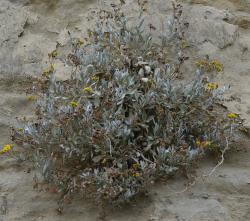- Taxon
- Gallery
- = Senecio colensoi Hook.f., Bot. Antarct. Voy. II. (Fl. Nov.-Zel.) Part I, 147 (1853)
- = Senecio banksii var. β velleia Hook.f., Bot. Antarct. Voy. II. (Fl. Nov.-Zel.) Part I, 146 (1853)
- = Senecio banksii var. γ scabrosus Hook.f., Bot. Antarct. Voy. II. (Fl. Nov.-Zel.) Part I, 146 (1853)
- = Senecio odoratus Hook.f., Handb. New Zealand Fl. 160 (1864) nom. illeg., non Senecio odoratus Hornem. 1815
- = Senecio pumiceus Colenso, Trans. & Proc. New Zealand Inst. 21: 89 (1888 [1889])
- = Senecio pumiceus var. angustatus Kirk, Stud. Fl. New Zealand 342-343 (1899)
- = Senecio colensoi var. lobulatus Allan, Fl. New Zealand 1, 747, 975 (1961)
- = Senecio colensoi var. obtusifolius Allan, Fl. New Zealand 1, 747, 975 (1961)
Ascending to erect perennial herb. Lvs glabrous or moderately to densely lanate especially on lower surface, apetiolate and often cuneate to amplexicaul base, elliptic, or elliptic-oblong to obovate, irregularly dentate to 1–2-serrate, lyrate-pinnatifid or 1-pinnatifid with oblong, few-toothed segments, or rarely crenately lobed, (2)–4–12–(20) × (1)–2–5 cm; teeth or segments (3)–7–20 or more on each side. Uppermost lvs smaller, narrower, often ± oblong or lanceolate, less divided and more conspicuously amplexicaul. Supplementary bracts 3–16–(20), 1.5–5 mm long. Involucral bracts 12–16–(19), glabrous, 2–5 mm long. Ray florets usually 7–13, very rarely as many as 22; ligules yellow, 3–8 mm long. Achenes with 1–3 rows of hairs in narrow grooves between broad ribs, not or scarcely narrowed to apex, 2–2.8 mm long.
[From: Webb et al. (1988) Flora of New Zealand. Volume 4.]
Flowering: Nov.–Feb.–(Jun.)




